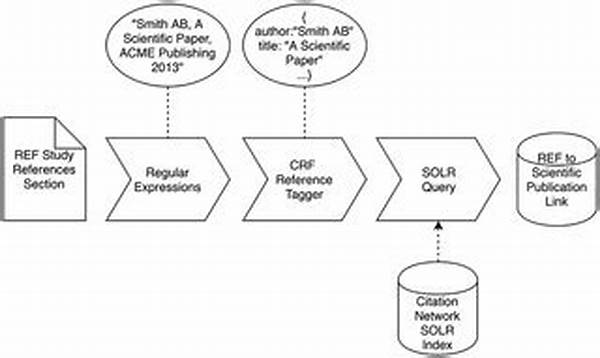In the realm of academia, impact metrics serve as critical yardsticks for evaluating the influence and quality of scholarly work. As the competition within academic fields intensifies, understanding these metrics becomes imperative for researchers, institutions, and policymakers alike. Impact metrics in academia are tools used to measure the impact and reach of academic research, often influencing decisions about funding, promotions, and the direction of future research. These metrics are pivotal not only for evaluating individual performance but also for shaping the intellectual and collaborative landscapes of academic disciplines.
Read Now : **optimizing Api Calls For Performance**
The Importance of Impact Metrics
Impact metrics in academia are indispensable in quantifying the significance of scholarly outputs. They provide insights into how often a piece of work is cited and recognized in its field, thereby helping to establish its validity and groundbreaking nature. For researchers, understanding these metrics allows them to target high-impact journals and collaborate with top-tier institutions. Institutions, on the other hand, use these metrics to attract talent, secure funding, and enhance their prestige on the global stage. Moreover, these metrics enable policymakers to gauge the effectiveness of investment in research by identifying areas with the most significant potential for societal advancement.
In recent years, the debate on the accuracy and fairness of impact metrics in academia has gained momentum. While metrics such as the h-index, journal impact factor, and citation counts are widely used, they have been criticized for potential biases and overemphasis on quantitative rather than qualitative measures. To address these challenges, the academic community is increasingly focusing on developing more holistic approaches that value research quality, societal impact, and interdisciplinary collaboration. Such efforts aim to ensure that the assessment of academic work contributes constructively to the evolution of science and knowledge dissemination.
Diverse Metrics Utilized
1. Citation Counts: These are the most straightforward forms of impact metrics in academia, tallying how often a work is referenced by other scholars.
2. H-Index: This metric combines productivity and citation impact by measuring the number of papers published and the number of citations received.
3. Journal Impact Factor: Calculated on the frequency of article citations from a specific journal, it gauges the relative importance of a journal within its field.
4. Altmetrics: These reflect the broader impact of work by considering mentions in social media, news outlets, and policy papers, thereby providing a more versatile view of impact metrics in academia.
5. ResearchGate Score: This encompasses a composite measure of engagement with an academic’s research outputs, taking notes, questions, and followers into account.
Challenges in Implementing Metrics
The quest to accurately implement impact metrics in academia is fraught with challenges. A primary concern is that traditional metrics often undervalue qualitative aspects of research, focusing heavily on numbers rather than the substantive contribution of work. This bias potentially marginalizes innovative research that may not be immediately recognized through high citation counts. Furthermore, existing metrics tend to favor established research areas, inadvertently discouraging exploration in nascent or interdisciplinary domains. In response, there’s a growing advocacy for a shift towards alternative metrics that encompass both academic and societal influences, fostering a more inclusive and comprehensive evaluation framework.
Read Now : Elite Journals For Academic Submissions
While impact metrics in academia are invaluable for gauging scholarly merit, the tendency to prioritize them without context can lead to distorted assessments. The pressure to publish in high-impact journals may induce a publish-or-perish culture, inadvertently undermining research integrity. As academia diversifies, there’s an increasing need to develop metrics that transcend conventional boundaries to encompass the wider societal impact of research. This involves expanding evaluation paradigms to accommodate diverse research outputs and influence pathways beyond citations, thereby promoting a more integrated approach to assessing scientific contributions.
Interpreting Impact: A Closer Look
Understanding impact metrics in academia necessitates a nuanced interpretation of what these indicators represent. Firstly, while citation counts can reflect a researcher’s domain influence, they may also be swayed by factors such as publication length and accessibility of the work. Secondly, the h-index, which combines both quantity and citation impact, can be skewed by prolific authors who garner moderate citations across numerous papers.
Thirdly, the journal impact factor remains subject to criticism due to its focus on a narrow citation window, which overlooks the enduring influence of seminal works. Moreover, altmetrics offer a broader perspective by evaluating online engagement, yet their reliability can vary greatly based on fluctuating public and media interests. Altogether, while these impact metrics in academia provide valuable insights, a comprehensive assessment should take into consideration both quantitative and qualitative dimensions to accurately reflect the academic landscape.
Future Directions and Innovations
As the academic domain evolves, the future of impact metrics in academia looks towards a more integrative and responsible measurement system. This future aims at recognizing the multidimensional nature of research, emphasizing the importance of interdisciplinary work and societal engagement. There is an increasing call for metrics that extend beyond traditional boundaries, incorporating digital footprints, collaborative networks, and real-world applications. Such a holistic perspective advocates for a balanced evaluation that values both scholarly and non-academic contributions, thereby acknowledging the full spectrum of research impacts.
In this context, the academic community is tasked with establishing standards that align with innovative methodologies and technological advancements. This involves concerted efforts to formulate metrics that can accommodate the dynamic and interconnected landscape of modern research. Institutions and funding bodies are urged to complement traditional bibliometric measures with new indicators that highlight diverse research paths and outcomes. Enhancing transparency and addressing biases in existing systems remain paramount to ensuring that impact metrics in academia continue to serve as reliable tools for fostering knowledge expansion and societal progress.
